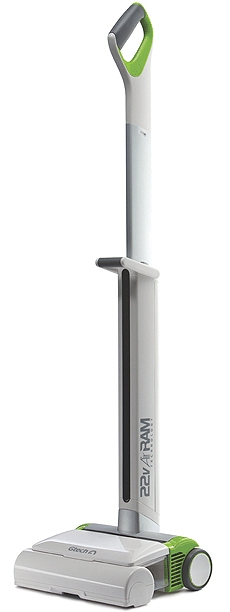GTech’s AirRam device uses a novel arrangement of off-the-shelf components to compact and store dust a short distance from the collection point — negating the need for a long suction length and associated power.
The core of GTech’s current business is a cordless sweeper with a brush bar powered by a ~7V motor, with no suction. These are sold as an adjunct to vacuuming, but as Nick Grey, founder of GTech, explained, the ambition has always been to produce a model with suction.
‘If you go back to the 1940s, Hoover was getting very good results from 250W using a reasonable brush bar and a half-decent amount of air flow — you don’t need thousands of Watts of suction, it doesn’t really aid anything — it’s there for the benefit of marketers.’
In the AirRam there is a single 22.2V direct current motor, which powers the brush bars and also drives a fan to compress the dirt into bales that can be dropped in a bin. The motor is supplied by a mains-charged lithium-ion battery pack with a 40-minute runtime.
The distance between the sweeper and bales is around 5cm, which Grey says accounts for the low power rating of 100W.
‘Vacuum cleaners are obsessed with going through tubes, you’ve got this hole the size of a 50p and a head that’s a foot wide and they use all their power getting the dirt off the floor to this tube and on the way half of it goes back on carpet — gravity takes its effect.’

The compression of the dust is not done mechanically and apparently relies on natural aggregation into bales.
‘We have a very broad inlet and when dust and dirt comes in at a normal speed, it gathers itself into a bale. As soon as you’ve started to get a bit of fluff build-up, the dust hits it and it gently drags it into a tighter and tighter bale. You’d think you need some extraordinary force but you don’t — it comes together quite nicely,’ Grey said.
GTech commissioned IBR laboratories of Spetchley to perform evaluative tests of the AirRam.
Test methodology supplied to The Engineer by GTech indicates that dust is deposited on a carpet at a concentration of 125g/m2 and the vacuum then performs 10 strokes at 0.5m/sec under standard humidity conditions.
The amount of test dust to be used is calculated by multiplying the cleaning width head by 125 then by 0.7 (which is the length of the test area in metres).
The dust removal ability is calculated as the ratio of the weight increase of the dust receptacle and removable filters during the five double strokes to the weight of the test dust distributed on the test area.
After averaging data from three separate tests the AirRam displayed a dust removal efficiency of 60.4 per cent.




Swiss geoengineering start-up targets methane removal
No mention whatsoever about the effect of increased methane levels/iron chloride in the ocean on the pH and chemical properties of the ocean - are we...